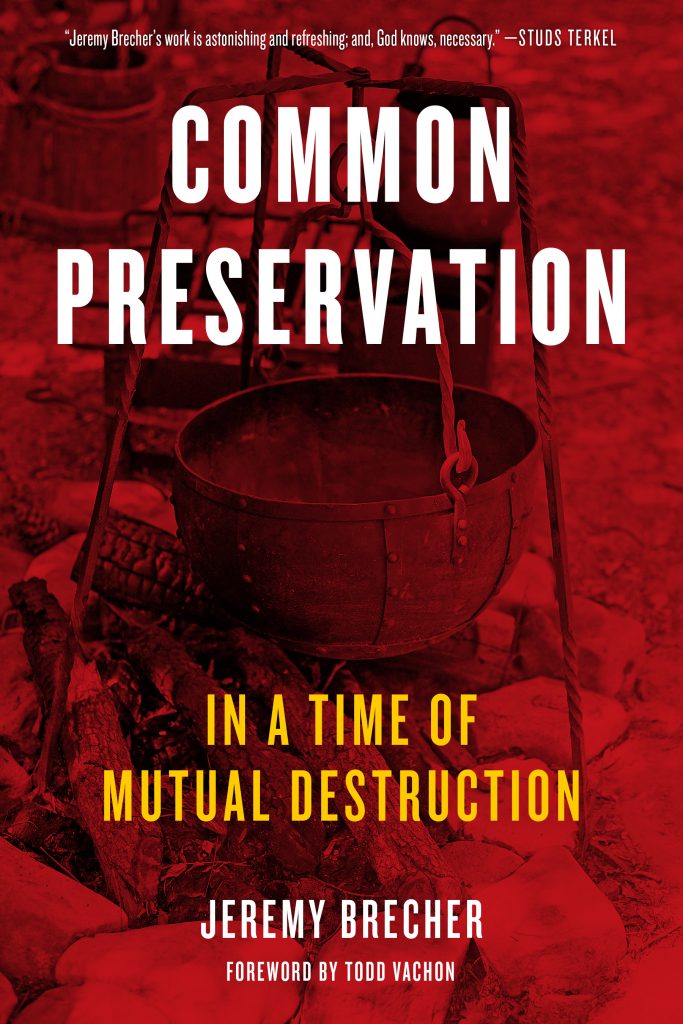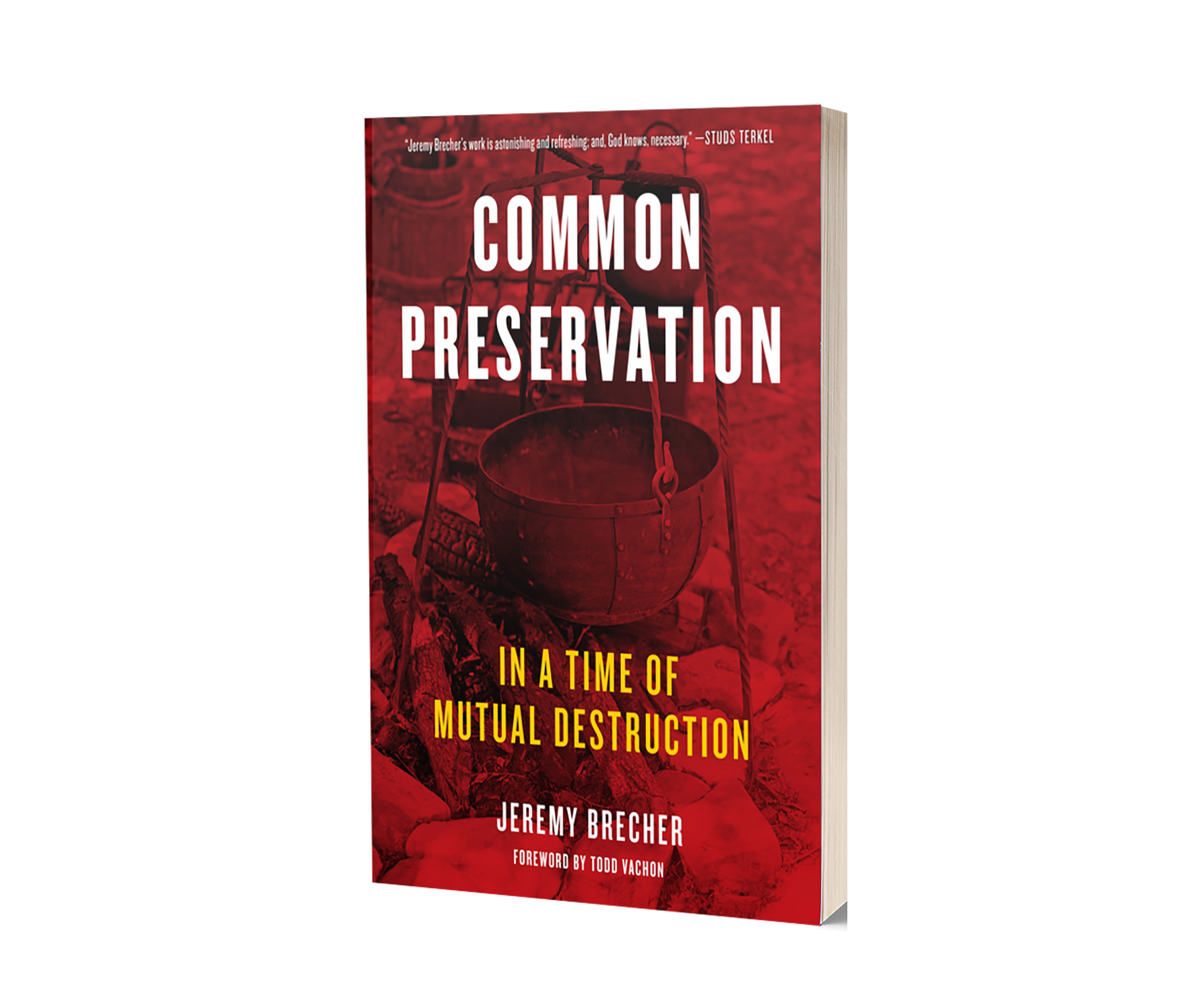Historian Jeremy Brecher’s new book shows how everyone can find a place and a role in the movement to address the climate crisis.
By Dalilah Shemia-Goeke
Waging NonViolence
August 15, 2022
This book review is from the new 2022 issue of Journal of Resistance Studies (Vol. 8 No.1).
While I was putting together some tools for my research to assess the effectiveness of resistance strategies challenging corporations, I came across Jeremy Brecher’s “Common Preservation: In a Time of Mutual Destruction,” published by PM Press in 2021. It is a complete toolbox covering everything from identifying and analyzing to solving societal problems. Not just any problems, but addressing the most pressing issue of our times: climate destruction. The person who compiled these conceptual tools into an actionable heuristic device is Jeremy Brecher, the author of “Strike!” a widely read book that narrates the history of mass strikes in the U.S. during the early 20th century. Brecher was only 27 when he wrote this debut work in 1972, which has been translated into several languages, and many interesting and inspiring publications have followed ever since.
Although sometimes Brecher is referred to as a labor historian, he has also written about the history of other movements, particularly the climate movement and globalization from below. With activism and writing, he is committed to contributing to social change, particularly social-ecological transformation. Brecher has put considerable effort into bringing the labor movement and the climate movement closer together, uniting forces to overcome the destructive consequences of the fossil-fueled economy. In his latest book, in which he shares his mentioned “toolbox,” he brings all this together — his past experiences, insights and reflections from half a century of dedicated engagement in activism and theory in a variety of different areas.
In “Common Preservation,” Brecher tells how he discovered key concepts that helped him make sense of the mess we are in and how to strategize our way out. As such, it is an intellectual autobiography, as Brecher is taking stock of everything he has learned during his life about how people can act together more effectively. Yet at its core, this book is about how people can collectively develop abilities to act together in a way that prevents the self-destructive consequences of current human behaviors. It provides tools for analysis, collective coordination and action to achieve shared goals, such as the protection of the climate. As the title suggests, the overall framing of the book is to explain how people sometimes shift from self-preservation as the “first law of life,” which can lead to situations in which each person fights against everyone else, to “common preservation,” which he defines as actions that allow people “to cooperate to realize their collective ends.”
The book is divided into three parts. In part one, Brecher tells how he came across the various key concepts, why they felt meaningful to him, and which puzzles they helped him solve. Part two discusses the various tools for analysis, shows how they can be used, and what function they fulfill in the broader quest of shifting to common preservation. These analytical and strategic “instruments” cover the entire process, from problem identification, strategizing, effective collective coordination, to countering domination and disorder, and how to prevent the new forms of cooperation leading to oppressive or chaotic results. In part three they are applied to the collective task of protecting the climate. After outlining the historical development of the climate movement, he suggests a way forward and concludes with an outlook for the future of collective action for shared goals.
It is fascinating how the author manages to bring together and combine thinkers and concepts that at first glance seem to be incompatible or from unrelated areas of scholarship. His central underlying foundation is Jean Piaget’s theory of human development, according to which people learn and grow because they want to overcome the unpleasantness of imbalance and return to a balanced state. This process is called equilibration. While likening the development of social movements to the development from childhood to adulthood can be problematic, due to the implicit infantilization of movements, drawing some cautious parallels may be helpful to understand some of the drivers of transformation of the organizational forms and strategic approaches of movements. Ultimately, the risk of linearity inherent in developmental models is balanced by the systemic thinking of the author.
Then, Brecher borrows from a diverse bouquet of scholars to complement this basic model, as he explores “the methodology of history, the dialectics of Karl Marx, the pragmatism of John Dewey […] paradigms of cybernetics and systems theory.” Brecher even draws on mathematics to use the concept of heuristic tools, which are conceptual models that help solve a problem. He introduces the notion of heuristic devices to explain the purpose of the 13 tools he presents and applies; they facilitate understanding and solving the problem of how to shift from self-preservation to common preservation. His conceptualization of power is of particular importance and relevance to anyone interested in comprehending how collective action can be effective. In his framework, Brecher, “drew on historical sociologist Michael Mann’s ideas about power as rooted in social networks. From Gandhi and his great interpreter Gene Sharp,” he writes, “I learned to view power as rooted in dependence, and see the apparently powerless as potentially powerful because of the mutual dependence that exists within a social system.”
Brecher elegantly mediates in the often-dichotomous debate between Weberian power-over thinkers and those who agree with Gene Sharp, as he shows how both can be true at the same time. Although this book is a brilliant orchestration of a multitude of highly intellectual components, it is written in very accessible, non-academic language, with many examples from a variety of social movements, including his own personal experiences as a participant, which makes the discussion very tangible and easily comprehensible.
In the third and last part of the book, the author applies the tools he has assembled with new combinations of existing concepts to the climate movement. He starts by showing how many elements of the current world order, such as nation states and private property rights, contribute to the destruction of the foundations of human life on this planet, and how the movement that tries to protect these is an expression of common preservation. He briefly narrates the history of the attempts to halt climate change from the 20th century to today, by showing the limits of lobbying and making clear that it is necessary to also employ methods of nonviolent direct action and civil disobedience to withdraw support and consent from the elements of the world order that lead to mutual destruction.
To illustrate how it could be done, Brecher then gives the example of the climate justice organization 350.org. Its name refers to the target threshold of 350 parts of carbon dioxide per million molecules in the atmosphere, which is scientifically considered a relatively “safe” level of CO2, while currently we are at almost 420 parts per million. The organization was co-founded by Bill McKibben, and inspired by a reading class about the civil rights movement. 350.org has supported the disruption of fossil fuel projects — such as the Keystone XL pipeline — global days of civil disobedient actions, for example Break Free from Fossil Fuels, as well as the global fossil fuel divestment campaign “Fossil Free.”
Sign Up for our Newsletter
We’ll send you a weekly email with the latest articles.
Brecher sees in these attempts a miniature foreshadowing of a much larger and encompassing movement he envisions. He proposes a global nonviolent insurgency defying the authorities that allow the destruction of life on earth. He goes on to delineate a very detailed transition plan, from where we are to an entirely fossil-free society, which reads like a radical utopia of community- and council-based direct democracy, social justice and liberation. Like many others before him, he sees in the pressing issue of climate emergency a unique opportunity for general socio-ecological transformation and explains how and why overcoming all other forms of oppression and domination are necessary to overcome the destruction of climate and biodiversity.
While this may have the potential to inspire, it can also overwhelm. If all this is necessary to halt the worst consequences of the climate crisis, then the outlook seems grim. What Brecher proposes is nothing short of a general revolution, which neither feels realistic, in terms of getting all these required constituencies on board, nor is it guaranteed that the disordered state of overthrowing governments all over the world will automatically result in a more egalitarian society. There are many uncertainties and potential missteps in his program. Notwithstanding, he offers such a great variety of suggestions of what could be done at all levels of society and action that his plan provides ample opportunities for everyone to find a place and a role.
This book is highly recommended for activists seeking inspiration for innovative ways to think about strategy, as well as for scholars who look for impulses on how research and academic work can be put in service of movements, while still staying committed to truth-seeking that is rooted in reason and evidence. And it is for both activists and scholars alike who yearn for non-dogmatic ways to learn about social change.
This story was produced by Resistance Studies
Dalilah Shemia-Goeke
Dalilah Shemia-Goeke is a PhD researcher at the University of Wollongong, Australia. Her research focuses on how nonviolent action can be used to curtail corporate power. She has been a labor organizer, peace worker and facilitator of workshops on effective grassroots strategies.







